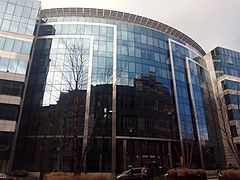Triangle building
| EEAS Headquarters | |
|---|---|

The Triangle building.
|
|
| Former names | JECL |
| Alternative names | The Capital building The Axa building |
| General information | |
| Type | Office building |
| Architectural style | Postmodern |
| Location | Brussels, Belgium |
| Address | 1 Kortenberglaan / Avenue de Cortenbergh Brussels 1040 Belgium |
| Coordinates | 50°50′33″N 4°23′8″E / 50.84250°N 4.38556°ECoordinates: 50°50′33″N 4°23′8″E / 50.84250°N 4.38556°E |
| Current tenants | The EU diplomatic service (EAS) and personnel selection office (EPSO) |
| Completed | 30 June 2009 |
| Landlord | AXA |
| Technical details | |
| Floor count | 7 |
| Floor area | 60,000 m² |
| Design and construction | |
| Architecture firm | Genval Workshop ELD |
The EEAS Headquarters (initially also known as The Capital, and sometimes referred to as the Triangle building) is the building in which most of the European External Action Service (EEAS) resides. The office building is on Schuman roundabout in the heart of the European Quarter of Brussels, Belgium. The building also houses some other EU departments. The EEAS staff moved into the building in February 2012.
The main structure was completed in 2009. It replaced an architecturally diverse complex of buildings that was previously located there, named JECL after the initials of the three surrounding streets: Avenue de la Joyeuse Entrée, Avenue de Cortenbergh and Rue de la Loi. When it was decided that the old JECL complex was to be demolished, the European Commission signalled its interest in purchasing the property in order to build a new EU conference centre on the site. The negotiations between AXA and the Commission were tough and lasted for more than five years, but eventually failed in 2006 due to disagreement over the price. Axa instead built the current building, which they called the The Capital, which is divided into distinct office blocks.
Axa intended to split the complex between the Commission, national embassies and private companies. However the Commission refused to share the building. Negotiations became drawn out but as of August 2010 the Commission and Axa were close to a signature for the whole building. In July 2010 European Personnel Selection Office (EPSO) entered one of the six parts of the buildings, occupying 9000m² out of a total of 54000m². It was later joined by the Foreign Policy Instruments Service (FPI) and the EEAS, whose staff had previously been dispersed across six buildings.
The triangular building is divided into 6 technically independent sections, named after the capitals of the six founding member states of the European Union (EU): Rome, Paris, Berlin, Luxembourg, Amsterdam and Brussels, respectively. In the centre is a large circular courtyard which is heavily planted and, in 30 years from its construction, the architect insisted it will look "magnificent".
...
Wikipedia
